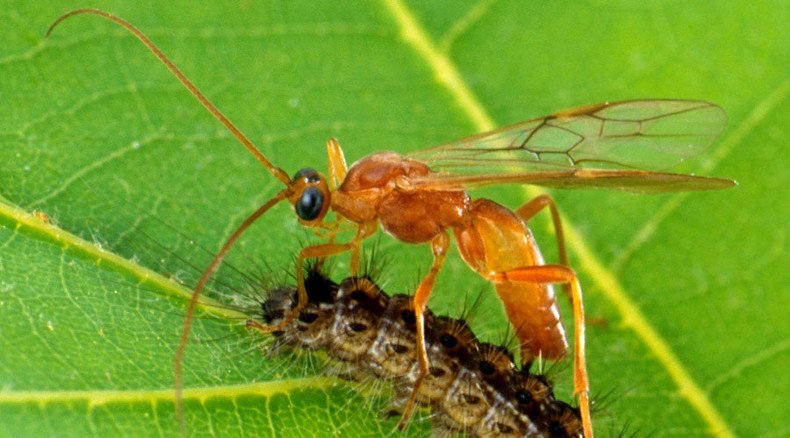How to get GM butterfly? Make parasitic wasp inject deadly virus into caterpillar, study finds

Nature is full of surprises, and its newest twist is a blessing and a curse for butterflies. Wasps have managed to genetically modify the creatures by accidentally sharing DNA, which protects them from viruses. Sadly, many caterpillars have died along the way.
A team of researchers from French and Spanish universities has discovered that pieces of DNA from a virus carried by parasitic wasps have infiltrated the genomes of the butterflies they attack. Their research was published in the journal PLOS Genetics.
The attack process is a brutal one, if you're a caterpillar. Identifying their targets, the wasps inject their eggs into the creatures after paralyzing them with a sting. The eggs develop into larvae and eventually eat the creature from the inside out, robbing their chances of becoming colorful butterflies.
Spiders are not as repulsive as they could be … zombied by wasps http://t.co/SUBf5szSMlpic.twitter.com/ECXDWMC8Iv
— RT (@RT_com) August 7, 2015The wasps have been discovered to host the group of viruses known as bracovirus in their ovaries, which allows them to pass it through their eggs.
“We show that in several lineages, lepidopteran genomes have acquired genes from a bracovirus that is symbiotically used by parasitic wasps to inhibit caterpillar host immune defenses,” the researchers said.
There is, however, is a silver lining to this seemingly cruel process. Since the DNA has managed to make it into the genomes of butterflies – perhaps from resilient caterpillars who survived attacks – it actually benefits the creatures by protecting them against another family of deadly viruses – baculovirus, a common field pathogen.
“What’s kind of funny is that such a species as iconic as the monarch [butterfly] has been genetically modified by the parasitic wasp virus and can thus be considered as a natural GMO,” study author Jean-Michel Drezen from Francois Rabelais University told the Atlantic.
Laila Gasmi, a geneticist at the University of Valencia, and her colleagues called the discovery “unexpected,” adding that the findings could be the “tip of the iceberg.”
Nope this is not #Aprilfools prank: #Monsanto pledges $4mn to save monarch butterflies http://t.co/3yXXa7YKUppic.twitter.com/tRSpNXhY2I
— RT (@RT_com) April 1, 2015“This phenomenon is not merely a curiosity but has most likely played an important role in the arms race between Lepidoptera (butterflies and moths) and their pathogens,” she said.
To understand the relationship between wasp, virus, and caterpillar, the scientists analyzed a computer database containing DNA from multiple species of moths and butterflies – including the monarch butterfly and the silkworm moth Bombyx mori – for sequences similar to a known segment of bracovirus DNA.
The initial search showed that certain segments of the moth and butterfly genome (known as the lepidopteran genome) closely resembled bracovirus sequences.
The scientists' computer research was confirmed by grinding up insect specimens, extracting DNA, and finding the presence of bracovirus integrations. Interestingly, they also found that wasp genes often infiltrate the caterpillar genome via the infecting virus.
Drezen and Salvador Herrero from the University of Valencia have now found similar genes in a wider range of butterflies and moths, including the beet armyworm and fall armyworm.
In addition, the researchers said there could be many other genes from different species of parasitic wasp infiltrating the genomes of butterflies.












